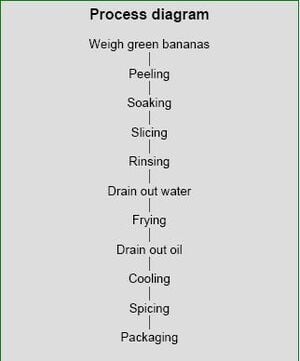
This technical brief is based on an investigation of what a Sweet banana chips project might look like as an income generating activity for the NGO Savings Group in Bangladesh.
There are several different types of banana chips:
- Banana figs -These are bananas which are cut into slices and then dried either in the sun or by artificial means.
- Savoury banana chips -These are banana slices which have been predried for a short period of time (eg 5 -6 hours) until they have a slight rubbery texture. It is difficult to give an exact drying time as bananas will have differing water contents. In such cases it is best to test by trial and error. After drying, the slices are fried in hot oil until they turn a golden brown colour. They are drained in order to remove the excess oil, and subsequently flavoured with a variety of spices.
- Sweet banana chips -These are bananas slices which have either been soaked or dipped in a strong sugar syrup or honey.
Banana chips are crispy snack food similar to potato chips. Most producers use plantains rather than desert bananas. Chips are normally made from under ripe fruits by frying the slices in oil.
Green bananas are available in many parts of Bangladesh. There are two types of ANAS bananas. One variety is fatter and shorter with a short stem. The end tapers to a thin point. This banana has a soft skin. The other type is longer and thinner with a longer stem. The end of the banana is thicker; it does not taper to a point. The skin is harder and thinner. The second type of banana (long type) is preferred.
The market for banana chips might be considered to be primarily children of school age. Label, design, and promotional materials might also be targeted to this group.
Preservatives / Additives[edit | edit source]
A preservative is any substance which, when added to a food, prevents or retards its spoilage. The additives contribute texture, taste, and colour to the product.
- Preservatives: Sulphur dioxide, carbon dioxide, benzoic acid, ascorbic acid, and citric acid.
- Blanching : Consist of immersing of product in water at a temperature of 95°C for a variable period of time. The temperature and the duration depend on the species, its state of maturity and its size.
- Use of Sulphites: Bi-sulphite of sodium, potassium, and calcium. Meta bisulphites of Sodium and potassium.
- Use of sodium bicarbonate: Sodium Bicarbonate
- Acidity and pH: Acidity may be expressed in terms of hydrogen ion concentration, a solution being described as acidic if its hydrogen ion concentration is greater than 10. A solution is basic if its hydrogen ion concentration is less than 10. ie pH = -log (H)
- Enzymes: Enzymes may cause deterioration of foods, they can also be used in food processing to produce particular products or modify the characteristics of particular products.
- Water activity: Micro organism grow only when water is available. Water activity aw has been coined to express the degree of availability of water in food.
- Rancidity : One of the major problems in storage of food material, changes taking place in lipids is generally referred to as rancidity.
Banana chips processing[edit | edit source]
It is important that they are sliced to an even thickness to avoid some being undercooked and others overcooked. The best way to do this is with either a hand vegetable slicer (commonly used on restaurants and hotels) or at larger scale with a rotating slicer of the type used to cut ham and bacon.
Raw materials:
- Green banana, Anaj (long type)
- Vegetable oil
Ingredients :
- Food colour Lemon-yellow, food grade.
- Common salt sodium chloride
- Beat salt
- Spices Red chilli powder, Cumin powder.
Additives :
- Sodium metabisulphite
Equipment/Utensils :
- Frying pan
- Frying spoon. Tea spoon
- Slicer
- Plastic bowl
- Knife
- Balance (Triple beame)
- Balance capacity - 3 Kg
- Screen
- Cotton towels
- Thermometer
- Chula

These products use a relatively low level of technology and require very little equipment, however, there is the constraint of marketing. Bananas are most usually consumed in the fresh state. To sell banana products therefore requires some very effective marketing.
In Sri Lanka banana chips were marketed as a snack food to be consumed with drinks prior to a meal. Another example is of dried and flavoured chips marketed as a healthy alternative to sweets and snackfoods, and aimed heavily at school children. These examples show that it is not only important to get the technology right, but the marketing is a vital area. It is therefore very important to assess the market for these products prior to production and evaluate the expected demands.
References and further reading[edit | edit source]
Banana Beer (Practical Action Technical Brief) [1]: Adding Value to Bananas Food Chain No 21, July 1997, ITDG: Traditional Foods: Processing for ProfitT by P. Fellows, IT Publications, 1997: Practical Action Bangladesh has produced a booklet on green banana chips production in Bengali